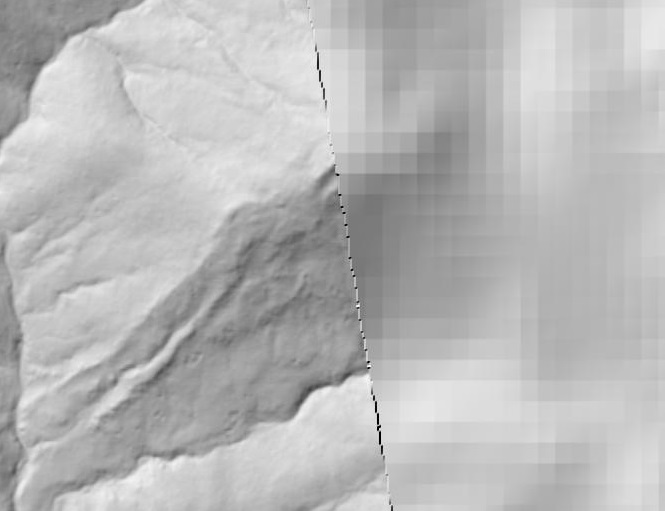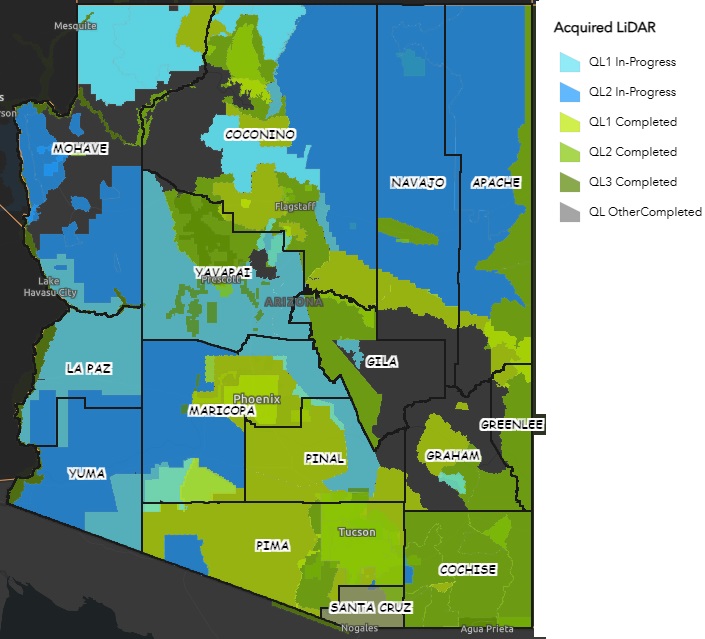|
What it is: LIDAR stands for Light Detection and Ranging, a method now used to map earth forms down to the meter. In many ways it supersedes the data shown on topographical maps, which dates from the 1960s in some cases. My primary source of information is here: USGS 3DEP Viewer. It can be a finicky, glitchy interface but when it works, it works well. You just have to think nice thoughts about it. For whatever reason, it only works satisfactorily when "Hillshade" is selected (first option in the left sidebar). Then, select "Contour" (7th option down). You can then select varying refinement of the contours. I use 5m for general purposes, but when I zoom in on a specific area, I use the 1m. Beware: it gets very cluttered. The dataset refinement definitions: An arcsecond is a subdivision of a circle. It is 1/60 of an arcminute, which in turn is 1/60 of a degree. Since there are 360 degrees within a circle, there are 60 × 60 × 360 = 1,296,000 arcseconds within a circle. Using an approximate value of 24,874 miles as the circumference of the earth (ignoring for the moment its irregular shape), one arcsecond is about 24,874 ÷ 1,296,000 = 0.0192 of a mile. A mile is 5,280 feet, so 0.0192 × 5,280 = 101.33 feet, which is about 31 meters. This is all rounded down to 30 meters, since the original radius measurement used is itself an estimation. Thus, 1 arc-second is about 100 feet (30 meters). From that, 1/3 arc-second is about 33 feet (10 meters) and 1/9 arc second about 10 feet (3 meters). The 1-meter data would be 1/27 arc-second if they continued by this nomenclature. Normally, it is just listed as 1-meter. What I do when measuring a summit and a saddle: Once I have zoomed in on a specific area, I do one of two things: 1. I select the "i" icon (lowerleft, first one down). This is the "Identity" or "Information" icon. Click it on a place on the map and it returns all sorts of information about that point: its elevation, slope, dataset source and so on. The dataset source ("Title") will mention whether it is "1 meter", "1/3 arc second" or "1/9 arc second" data. Below is an image showing land terrain where the more detailed 1-meter data is seen at the left, versus the older 10-meter (1/3 arc-second) seen at right. Clearly, there is far more detail with the 1-meter data. 
2. I select the "Ruler" icon (second one down, "Measure"). Click somewhere on the map, then somewhere nearby, and double click. A line appears, then a pop-up appears with an elevation profile along that line. You can select it in either meters or feet above sea level. The 1/3-arc second data sets are least trustworthy, no better than what's on the printed maps. In truth, what's on the printed maps is often quite accurate, taking into account a lot dates from the 1960s-1980s, and was limited by whatever technology was used then. But the 1/3-arc second renders elevations to about one every thirty feet, and often just uses "digitized" intrapolation from the older map data itself. It's not relying on newer satellite-laser-collected data. The 1/9 is better (about one elevation figure every ten feet). The 1-meter is most desirable and is based on actual newer data collected by the satellites. When I want to determine a summit's elevation and its key-col's elevation to determine the peak's prominence, here's what I do: For the summit, I zoom as close as possible at the 1m contour. Then I use the ruler icon and define line segments from one end of the summit contour to its opposite end, sometimes deliberatly offsetting from the center. I may do this ten or fifteen times. In each case, I then look at the elevation profile and look for the highest bump and its elevation. The highest of all such measurements is the summit elevation. I prefer to get two such cross-sections with the same highest-elevation figure as confirmation. For the key-col (the saddle), it gets trickier. I first draw segments from the two higher contours through the center, and look for the lowest elevation point. I deliberately will offset from the center, and will draw a variety of segments until I get a consistent reading. What I am looking for is the "highest low". Of all the cross sections, which one has the highest low elevation? That's probably the saddle elevation. But wait, I'm not done. Then I draw in segments between the two lower contours and look for the highest elevation in those cross sections, again doing this repeatedly and often criss-crossing the saddle region. Now I'm looking for a "lowest high", and at least a few such cross sections that agree with the "highest low" from above. If I get many confirmations of the "highest low" this way, that's better evidence that that "high low" figure is the saddle elevation. I only get this nerdy in the 1m data. For the 1/3 arc second datasets, there's no point because it won't reveal anything new. Naming a peak when it has no name: Many peaks do not have names. On the topographical maps, some have a spot elevation printed at its summit, but many do not. These usually have a highest contour and nothing more. • If there is a printed elevation on the map, then that numerical string becomes the peak's de-facto "map name". In my pages, I will list the peak by its map name, but in its metadata, provide the actual elevation given by Lidar, with a small green asterisk nearby that one can mouse-over to see a pop-up with the map elevation and the Lidar elevation. • If there is no printed elevation, then I assign the Lidar-derived elevation as its new peak name. A small green asterisk will be provided for a quick mouse-over with an explanation. Lidar progress in Arizona: About a quarter of Arizona is now covered in the 1m datasets. Most other states are fully covered. It seems the new datasets are released without fanfare. I randomly go onto the site and see if any new datasets have been dropped. I use it here only for cases of peaks at or near cut-offs for ranked status. I don't have the time nor inclination to use it for all peaks. My faith in it is strong but as with any toy, it has its own limitations, so whatever I include on my site should be seen as "best available data", not as gospel. I try to mention if it's 1m data or the coarser 1/3 arc-second data. Here is a map of the coverage of Arizona as of late 2022 (Courtesy AGIC - Arizona Lidar Acquisition Plan). Note that the western deserts and much of the Navajo, Hopi and Apache Nations do not have 1m data avilable. It appears these areas will be covered soon ... but that may be a couple more years. It also appears some areas won't get covered at all. 
|